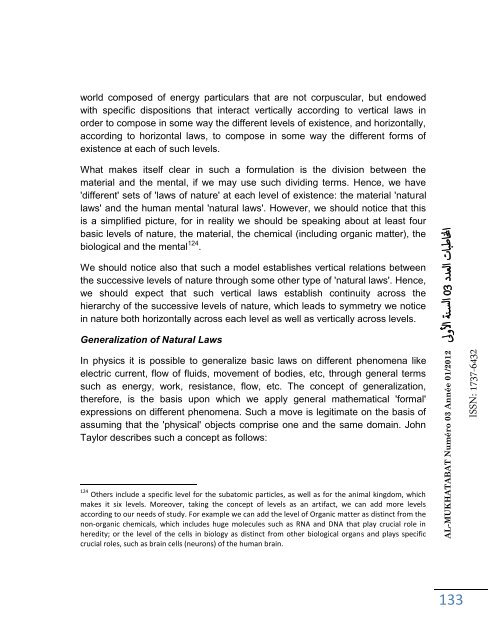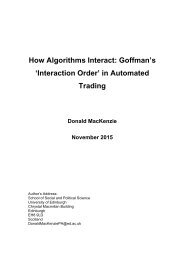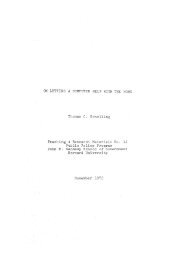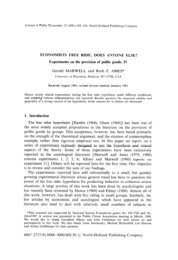n3-al-mukhatabat-journal
n3-al-mukhatabat-journal
n3-al-mukhatabat-journal
You also want an ePaper? Increase the reach of your titles
YUMPU automatically turns print PDFs into web optimized ePapers that Google loves.
world composed of energy particulars that are not corpuscular, but endowed<br />
with specific dispositions that interact vertic<strong>al</strong>ly according to vertic<strong>al</strong> laws in<br />
order to compose in some way the different levels of existence, and horizont<strong>al</strong>ly,<br />
according to horizont<strong>al</strong> laws, to compose in some way the different forms of<br />
existence at each of such levels.<br />
What makes itself clear in such a formulation is the division between the<br />
materi<strong>al</strong> and the ment<strong>al</strong>, if we may use such dividing terms. Hence, we have<br />
'different' sets of 'laws of nature' at each level of existence: the materi<strong>al</strong> 'natur<strong>al</strong><br />
laws' and the human ment<strong>al</strong> 'natur<strong>al</strong> laws'. However, we should notice that this<br />
is a simplified picture, for in re<strong>al</strong>ity we should be speaking about at least four<br />
basic levels of nature, the materi<strong>al</strong>, the chemic<strong>al</strong> (including organic matter), the<br />
biologic<strong>al</strong> and the ment<strong>al</strong> 124 .<br />
We should notice <strong>al</strong>so that such a model establishes vertic<strong>al</strong> relations between<br />
the successive levels of nature through some other type of 'natur<strong>al</strong> laws'. Hence,<br />
we should expect that such vertic<strong>al</strong> laws establish continuity across the<br />
hierarchy of the successive levels of nature, which leads to symmetry we notice<br />
in nature both horizont<strong>al</strong>ly across each level as well as vertic<strong>al</strong>ly across levels.<br />
Gener<strong>al</strong>ization of Natur<strong>al</strong> Laws<br />
In physics it is possible to gener<strong>al</strong>ize basic laws on different phenomena like<br />
electric current, flow of fluids, movement of bodies, etc, through gener<strong>al</strong> terms<br />
such as energy, work, resistance, flow, etc. The concept of gener<strong>al</strong>ization,<br />
therefore, is the basis upon which we apply gener<strong>al</strong> mathematic<strong>al</strong> 'form<strong>al</strong>'<br />
expressions on different phenomena. Such a move is legitimate on the basis of<br />
assuming that the 'physic<strong>al</strong>' objects comprise one and the same domain. John<br />
Taylor describes such a concept as follows:<br />
124 Others include a specific level for the subatomic particles, as well as for the anim<strong>al</strong> kingdom, which<br />
makes it six levels. Moreover, taking the concept of levels as an artifact, we can add more levels<br />
according to our needs of study. For example we can add the level of Organic matter as distinct from the<br />
non-organic chemic<strong>al</strong>s, which includes huge molecules such as RNA and DNA that play cruci<strong>al</strong> role in<br />
heredity; or the level of the cells in biology as distinct from other biologic<strong>al</strong> organs and plays specific<br />
cruci<strong>al</strong> roles, such as brain cells (neurons) of the human brain.<br />
AL-MUKHATABAT Numéro 03 Année 01/2012 لىولأا ةن سلا 30 ددعلا تابطانا<br />
133<br />
ISSN: 1737-6432







